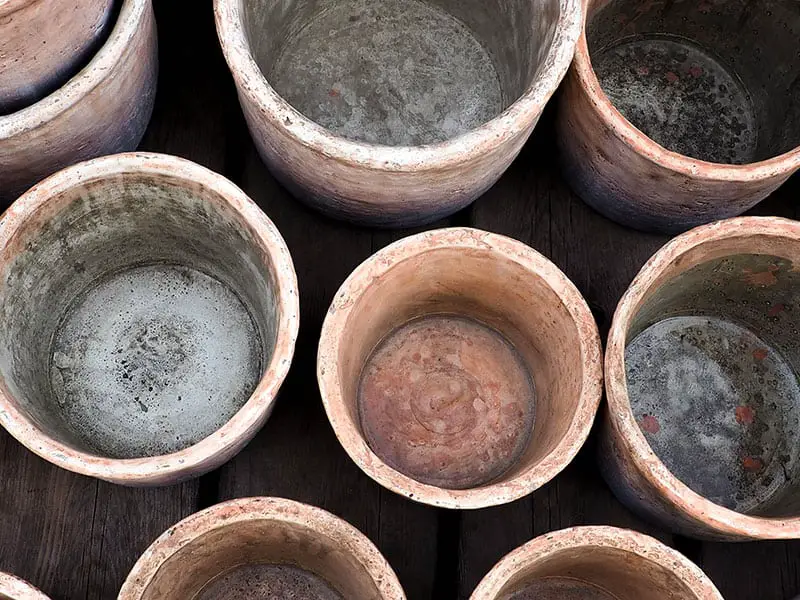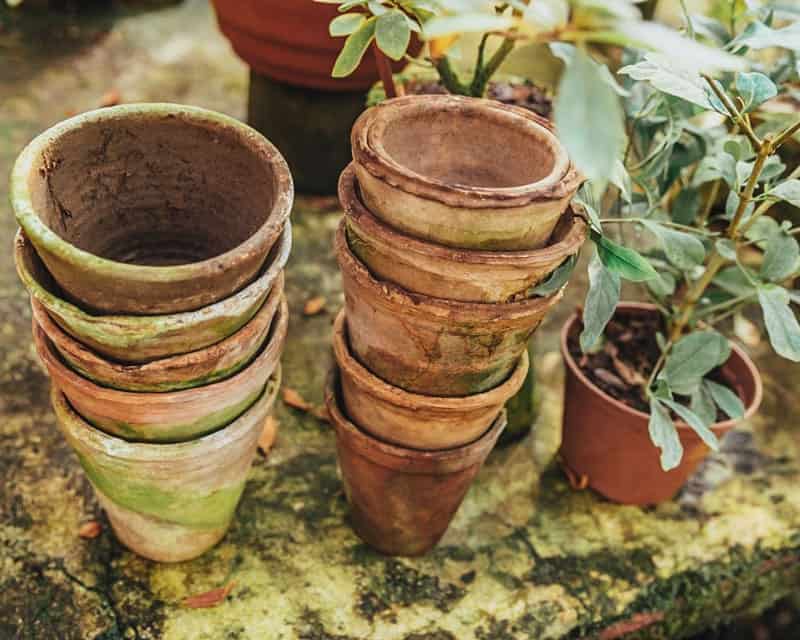
Terracotta pots are beautiful and should stay that way! But what happens if they start turning white?!
The white crust on the surface of terracotta pots is calcium, salt, and mineral buildup from hard water and fertilizers. A quick fix for this problem is to scrub the pot with a vinegar mix or bleach solution.
A white terracotta pot is not everyone’s favorite, but preventing and cleaning one is possible! Keep reading to figure out how to keep your terracotta pots look amazing.
What is this White Crust Building Up on my Terracotta Pots?
That crusty white buildup on your terracotta pots is a mineral salt deposit from hard water and fertilizers in the soil. Its technical term is efflorescence, although some people call it a patina.
This is a natural process that occurs because terracotta is porous. Even though they look solid to the naked eye, clay and terracotta pots have microscopic holes that allow water and minerals from the soil to travel through the pot. When the water evaporates, the mineral salts get left behind on the outside of the pot, which creates that white crust.
Some people really like the look of efflorescence on their terracotta pots. It certainly does give them an old, weathered look.
It’s even more interesting to see some retailers have picked up on this trend by selling “pre-aged” clay pots with a white finish. Of course, these are usually more expensive than their normal counterparts.
Salt and mineral blooms don’t harm the plants inside the pot, but if you don’t like the look, there are ways to remove the buildup and keep it from coming back.
Are These Deposits Harmful for Plants?
Efflorescence is not harmful to plants, as these salt deposits only exist on the outside of terracotta pots. It may become an issue for vining plants like Pothos that hang over and touch the side of the pot because coming into contact with too much salt can burn the stems and leaves.
While the salt deposit on its own is relatively harmless, it may be a sign that the soil has too much salt in it. These salts usually come from hard tap water and fertilizer. In addition to creating a deposit on the outside of the pot, too much salt in the soil can burn your plant. An efflorescence actually means your terracotta pots are working the right way to prevent excess mineral buildup in the soil that could burn your plant’s roots!
You can prevent salt burn by using a gentle fertilizer and by watering with rainwater. Flushing the soil every so often will also remove excess mineral salts from the soil, but it will not remove the white deposits on the pot.
Will All Terracotta Pots Turn White?

You should note that machine-made terracotta pots accumulate this salt buildup more slowly because the clay’s internal structure is more compact with fewer holes.
In contrast, pottery fired at a lower temperature may experience more efflorescence. This means that hand-crafted or artisan terracotta pots are more likely to display this white crust.
Once again, some people really like this look, but if it’s not your style, you should look for manufactured clay pots.
How to Prevent Terracotta from Turning white
Efflorescence is a natural process that can be disrupted in different stages. In order for mineral blooms to appear on the surface of a porous material like terracotta, three things need to occur:
- Presence of water
- Presence of mineral salts that can dissolve in water
- Evaporation of water, which leaves mineral deposits on the porous material’s surface
So, this means that in order to prevent your terracotta pots from turning white, you either need to reduce the presence of mineral salts in the soil or prevent water from evaporating from the pot’s surface. Technically, you could also remove the water source, but then your plant would die.
1. Use Distilled Water or Rainwater

“Hard” water refers to how many mineral salts (mostly calcium) are dissolved in the water. Nearly 90% of homes in the United States have hard water. When hard water evaporates, it leaves all of its minerals behind.
Watering your plants in terracotta with hard water can lead to those minerals getting deposited on the outside of the pot in a white, powdery crust.
You can prevent this by watering with distilled water or rainwater, as these have very low mineral content.
2. Choose a Gentler Fertilizers
Water can carry dissolved, unused fertilizer from the soil to the outside of the clay pot. All plants absorb fertilizer at different rates, and this can even change from one season to the next. Too much fertilizer in the soil will lead to a buildup which can burn the plant’s roots. In this situation, a white, salty crust may form on top of the soil and on the outside of a clay pot.
You can prevent this buildup and improve your plant’s health by reducing the amount of fertilizer you use.
Many plant food brands will recommend using a large dose of fertilizer very often. However, most plants usually only need half the recommended dose.
A gentle, organic fertilizer will be better for your plant and its pot. Make sure you also only feed plants during the active growing season!
3. Control the Humidity in the Air
Humidity in the air has a small part to play in this white crust as well. When the air surrounding your clay pots is very dry, any moisture in the pot itself will evaporate faster.
If it evaporates before reaching the surface, any minerals dissolved in the water will get deposited inside the pot where you can’t see them.
On the other hand, when there’s already a lot of moisture in the air, water traveling through the clay’s pores will evaporate much slower. A slower evaporation rate means that mineral-rich water will reach the outside of the pot, and that’s where it will deposit any salts it was carrying.
Also read: Complete Guide to Use a Humidifier for Houseplants
4. Apply Surface Sealers on Your Terracotta Pots
If you really want to prevent any efflorescence from building up on your pots, you need to seal the terracotta’s surface to keep the water out. You can seal either the inside or the outside of the pot. Keep in mind that using a sealer will prevent the terracotta from “breathing,” so the soil will hold onto water for longer.
Some surface sealers will also give the pot a glossy look. These are best used on the inside of the pot if you want to keep the clay’s natural matte texture on the outside.
Alternatively, you could use a penetrating sealer (like Miteq Sealer 102) which absorbs into the clay a little bit and sits just behind the surface. Using a penetrating sealer on the outside of your terracotta pot will prevent efflorescence and maintain the material’s natural matte aesthetic.
If you are going to seal the inside of your pot, you need to make sure the product is not toxic to plants. Concrete sealers are no good for this application, and I’ve heard that some waterseal brands can also hurt plants. Flex Seal and Rustoleum sealers are both safe (and shiny) options for this application.
Getting Rid of White Layer on Terracotta Pots
The best time to get rid of salt buildup on your pots is when repotting, preferably when the pot is still empty. It’s already a good practice to clean plant pots in between “occupants” to prevent diseases or pests from spreading from one plant to another. It makes sense to clean off any efflorescence at the same time.
Getting rid of the white crust may take a bit of hard work and elbow grease, but the process itself is quite simple. Let’s take a look.
Tools You Need
- Vinegar
- Water
- Tub big enough to soak the pot(s)
- Stiff scrub brush
- Rag
Directions
Step 1: Brush off excess crust with a stiff nylon brush.
An old toothbrush works great for this, although you might want something a bit larger if you have a lot of big pots to clean.
You should try to avoid wire metal brushes, as these can scratch and damage the terracotta surface.
There will probably still be a bunch of residue on the pot, so move on to the next step.
Step 2: Soak the pot to dissolve the salts.
Mix 1 part vinegar to 4 parts water in a large tub or plugged sink. The white buildup usually contains a lot of calcium from hard water, which dissolves easily in acids like vinegar.
Soak the pot for at least an hour. You can let it go longer if it’s a thick buildup. The diluted vinegar will not damage the clay.
Step 3: Use a rag or scrub brush to wipe and scrape white residue off the pot.
This is where you might need to put in some hard work! Depending on how much crust there is and how long it’s been there, it may be very stubborn and not want to come off.
Be patient! It will all come off eventually.
Step 4: Repeat steps 2 and 3 as necessary.
When your scrubbing arm gets sore, stick the pot back in its bath and walk away for another hour.
Grab a snack, go for a walk, or watch an episode of your favorite show. Then come back and show that crust who’s the boss!
Related Questions:
How about green algae, how to get rid of it?

If you notice something green growing on the outside of your terracotta pots, it’s probably algae. Algae grows as a thin, dark green film. It tends to grow on pots in shady areas that don’t dry out as fast.
Algae on the outside of a pot will not hurt the plant inside, but you can remove it if you don’t like how it looks. You can scrape algae off easily with a stiff nylon brush and soapy water.
Spray a diluted bleach solution to the outside of the pot to deter algae from growing for a while. This effect wears off when the bleach gets washed away over time.
To prevent algae from growing in the future, try moving the pot to a sunnier location or use a surface sealer on the terracotta.

